Related Research Articles
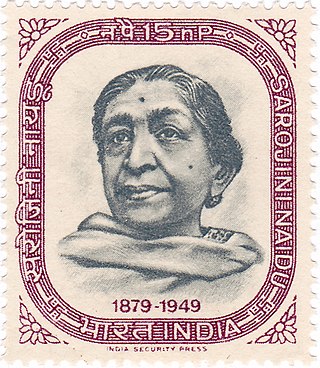
Sarojini Naidu was an Indian political activist and poet. A proponent of civil rights, women's emancipation, and anti-imperialism, she played an important role in the Indian independence movement against the British Raj. She was the first Indian woman to be president of the Indian National Congress and to be appointed governor of a state.

Ayillyath Kuttiari Gopalan, popularly known as A. K. Gopalan or AKG, was an Indian communist politician. He was one of 16 Communist Party of India members elected to the first Lok Sabha in 1952. Later he became one of the founding members of the Communist Party of India (Marxist).
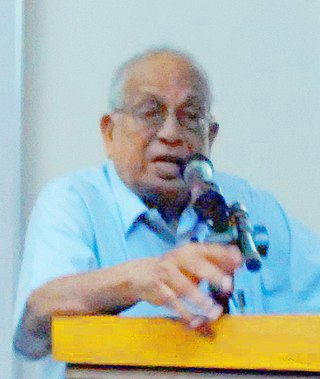
Subbiah Muthiah,, was an Indian writer, journalist, cartographer, amateur historian and heritage activist known for his writings on the political and cultural history of Chennai city. He was the founder of the fortnightly newspaper Madras Musings and the principal organizer of the annual Madras Day celebrations. Muthiah was also the founder-President of the Madras Book Club.

Bhogaraju Pattabhi Sitaramayya was an Indian independence activist and political leader in the state of Andhra Pradesh. He was also the first governor of Madhya Pradesh. Books Written By Him - 1. National Education 2. INDIAN NATIONALISM 3. Economic Conquest of India 4. Gandhi,Gandhism and Socialism

Theosophical teachings have borrowed some concepts and terms from Buddhism. Some theosophists like Helena Blavatsky, Helena Roerich and Henry Steel Olcott also became Buddhists. Henry Steel Olcott helped shape the design of the Buddhist flag. Tibetan Buddhism was popularised in the West at first mainly by Theosophists including Evans-Wentz and Alexandra David-Neel.

Naduvattam is a Panchayat town in The Nilgiris district in the Indian state of Tamil Nadu. It is located on Coimbatore-Gundalpet National Highway NH 67 of the Nilgiri Ghat Roads.
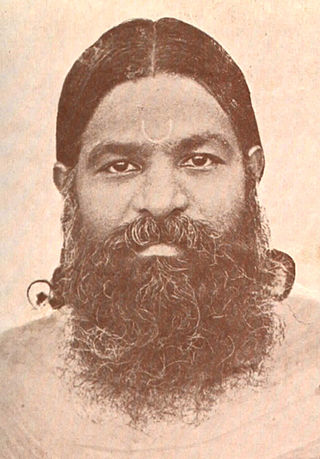
Varahaneri Venkatesa Subramaniam Aiyar, also known as V. V. S. Aiyar, was an Indian revolutionary from Tamil Nadu who fought against British colonial rule in India. His contemporaries include Subramanya Bharathi and V.O. Chidambaram Pillai, who subscribed to militant forms of resistance against the British colonial government. He went into exile in Pondicherry, then under French rule, when his militant activities attracted a warrant for his arrest from the British colonial government.
Chindian (Chinese: 中印人; pinyin: Zhōngyìnrén; Cantonese Yale: Jūngyanyàn; Tamil: சிந்தியன்; Telugu: చిండియన్స్; is an informal term used to refer to a person of mixed Chinese and Indian ancestry; i.e. from any of the host of ethnic groups native to modern China and India. There are a considerable number of Chindians in Malaysia and Singapore. In Maritime Southeast Asia, people of Chinese and Indian origin immigrated in large numbers during the 19th and 20th centuries. There are also a sizeable number living in Hong Kong and smaller numbers in other countries with large overseas Chinese and Indian diaspora, such as Jamaica, Trinidad and Tobago, Suriname and Guyana in the Caribbean, as well as in Indonesia, the Philippines, the United States, Canada, United Kingdom, Australia, and New Zealand.

Edgar ThurstonCIE was the British Superintendent at the Madras Government Museum from 1885 to 1908 who contributed to research studies in the fields of zoology, ethnology and botany of India, and later also published his works at the museum. Thurston was educated in medicine and lectured in anatomy at the Madras Medical College while simultaneously holding a senior position at the museum. His early works were on numismatics and geology, and these were later followed by researches in anthropology and ethnography. He succeeded Frederick S. Mullaly as the Superintendent of Ethnography for the Madras Presidency.

Andrew Humphreys was a U.S. Representative from Bloomfield, Greene County, Indiana, who served in the Forty-fourth Congress. Prior to the American Civil War, Humphreys was as a member of the Indiana House of Representatives, and an Indian agent for Utah. In 1864 Humphreys was a defendant in a controversial trial by a military commission that convened on October 21 at Indianapolis, where he and three others were convicted of treason. Humphreys was sentenced to hard labor for the remainder of the war, but the sentence was modified three weeks later to allow for his release. At the end of the war, Humphreys resumed a career in politics, which included terms in Forty-fourth Congress and the Indiana Senate.
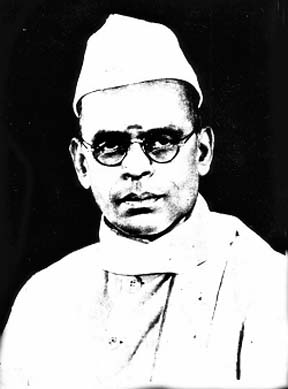
Sundara Sastri Satyamurti was an Indian independence activist and politician. He was acclaimed for his rhetoric and was one of the leading politicians of the Indian National Congress from the Madras Presidency, alongside S. Srinivasa Iyengar, C. Rajagopalachari and T. Prakasam. Satyamurti is regarded as the mentor of K. Kamaraj, Chief Minister of Madras State from 1954 to 1962.
K. P. Keshava Menon (1884?–?) was an Indian lawyer and a leading Indian independence activist from Kerala who was a key proponent of the formation of the Indian Independence League (IIL) and a lawyer for the Indian National Army (INA).
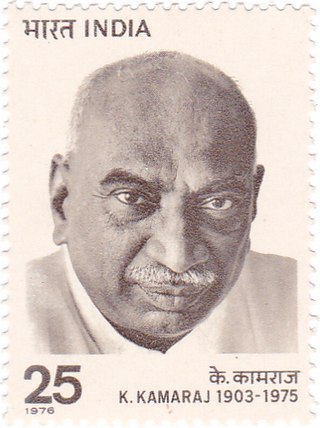
Kumaraswami Kamaraj, popularly known as Kamarajar was an Indian independence activist and politician who served as the Chief Minister of Madras State from 13 April 1954 to 2 October 1963. He was the founder and the president of the Indian National Congress (Organisation), widely acknowledged as the "Kingmaker" in Indian politics during the 1960s. He also served as the president of the Indian National Congress for two terms i.e. four years between 1964–1967 and was responsible for the elevation of Lal Bahadur Shastri to the position of Prime Minister of India after Nehru's death and Indira Gandhi after Shastri's death. He was the Member of Parliament, Lok Sabha during 1952–1954 and 1969–1975. He was known for his simplicity and integrity. He played a major role in developing the infrastructure of the Madras state and worked to improve the quality of life of the needy and the disadvantaged.
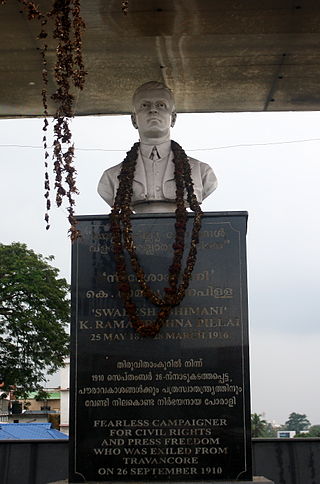
K. Ramakrishna Pillai (1878–1916) was an Indian nationalist writer, journalist, editor, and political activist. He edited Swadeshabhimani, the newspaper which became a potent weapon against the rule of the British and the erstwhile princely state of Travancore and a tool for social transformation. His criticism of the Diwan of Travancore, P. Rajagopalachari and the Maharajah led to the eventual confiscation of the newspaper. Ramakrishna Pillai was arrested and exiled from Travancore in 1910. Vrithantha Pathra Pravarthanam (1912) and Karl Marx (1912) are among his most noted works in Malayalam, Vrithantha Pathra pravarthanam being the first book on journalism in Malayalam and Karl Marx, the first ever biography of Karl Marx in any Indian language. But it has been alleged that he plagiarized the biography from an essay, Karl Marx:A Modern Rishi, by Lala Hardayal, published in 1912 March issue of the Modern Review, published from Kolkata.
Swadeshabhimani was a newspaper published in the Kingdom of Travancore, which was banned and confiscated by the Government of Travancore in 1910 due to its criticisms against the government and the Diwan of Travancore, P. Rajagopalachari.

Johann Philipp Fabricius was a German Christian missionary and a Tamil scholar in the later part of his life. He arrived in South India in 1740 to take charge of a small Tamil Lutheran congregation in Madras and expanded it during his stay. During his time in Madras he wrote several Christian hymns in Tamil and published the first Tamil to English Dictionary. Of his works his translation of the Bible to Tamil is considered to be most noteworthy.
The Lakshmikanthan murder case was a high-profile criminal trial that was conducted in the then Madras Presidency between November 1944 and April 1947. The cause of the trial was the murder of C. N. Lakshmikanthan, a Tamil film journalist. Lakshmikanthan was stabbed in Vepery, Madras, on 7 November 1944. He died the next morning in General Hospital, Madras.
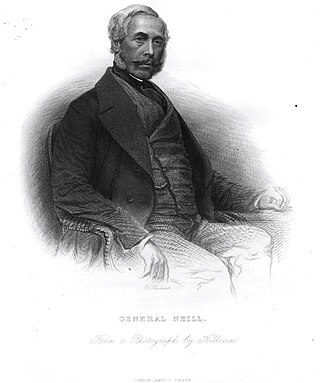
Neill statue Satyagraha was an agitation that took place in Madras Presidency, British India during the Indian Independence Movement. It took place in 1927 demanding the removal of the statue of Colonel James Neill situated at Mount Road in Madras.

Benjamin Guy Horniman was a British journalist and editor of The Bombay Chronicle, particularly notable for his support of Indian independence.
Tamil Lexicon is a twelve-volume dictionary of the Tamil language. Published by the University of Madras, it is said to be the most comprehensive dictionary of the Tamil language to date. On the basis of several precursors, including Rottler's Tamil–English Dictionary, Winslow's Tamil–English Dictionary, and Pope's Compendious Tamil–English Dictionary, work on a more exhaustive dictionary began in January 1913 and the first forms were printed by the end of 1923. Initially estimated at ₹ 100,000, the total cost of the project came to about ₹ 410,000. The first edition had 4,351 pages in seven volumes, including a one-volume supplement, which were printed between 1924 and 1939 and had 104,405 words, with an additional 13,357 words in the supplementary volume, totaling to 124,405 words in all.
References
- ↑ "The English Press in Colonel India". S.M.A. Feroze. The Dawn. 22 April 2017. Retrieved 11 September 2021.
- ↑ Reba Chaudhuri (22 February 1955). "The Story of the Indian Press" (PDF). Economic and Political Weekly.
- ↑ A. Ganesan (January 1988). The Press in Tamil Nadu and the Struggle for Freedom, 1917-1937. South Asia Books. p. 4. ISBN 9788170990826.